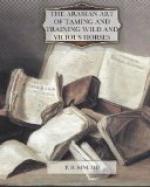We might very naturally suppose, from the fact of the horse’s applying his nose to every thing new to him, that he always does so for the purpose of smelling these objects. But I believe that it is as much or more for the purpose of feeling; and that he makes use of his nose or muzzle, (as it is sometimes called.) as we would of our hands; because it is the only organ by which he can touch or feel anything with much susceptibility.
I believe that he invariably makes use of the four senses, seeing, hearing, smelling and feeling, in all of his examinations, of which the sense of feeling is, perhaps, the most important. And I think that in the experiment with the robe, his gradual approach and final touch with his nose was as much for the purpose of feeling, as anything else, his sense of smell being so keen, that it would not be necessary for him to touch his nose against anything in order to get the proper scent; for it is said that a horse can smell a man the distance of a mile. And, if the scent of the robe was all that was necessary, he could get that several rods off. But, we know from experience, that if a horse sees and smells a robe a short distance from him, he is very much frightened, (unless he is used to it,) until he touches or feels it with his nose; which is a positive proof that feeling is the controlling sense in this case.
PREVAILING OPINION OF HORSEMEN.
It is a prevailing opinion among horsemen generally, that the sense of smell is the governing sense of the horse. And Faucher, as well as others, have, with that view, got up receipts of strong smelling oils, etc., to tame the horse, sometimes using the chesnut of his leg, which they dry, grind into powder and blow into his nostrils. Sometimes using the oil of rhodium, organnnum, etc.; that are noted for their strong smell. And sometimes they scent the hands with the sweat from under the arm, or blow their breath into his nostrils, etc., etc. All of which, as far as the scent goes have no effect whatever in gentling the horse, or conveying any idea to his mind; though the works that accompany these efforts—handling him, touching him about the nose and head, and patting him, as they direct you should, after administering the articles, may have a very great effect, which they mistake to be the effect of the ingredients used. And Faucher, in his work entitled, “The Arabian art of taming Horses,” page 17, tells us how to accustom a horse to a robe, by administering certain articles to his nose; and goes on to say, that these articles must first be applied to the horse’s nose before you attempt to break him, in order to operate successfully.
Now, reader, can you, or any one else, give one single reason how scent can convey any idea to the horse’s mind of what we want him to do? If not, then of course strong scents of any kind are of no account in taming the unbroken horse. For every thing that we get him to do of his own accord, without force, must be accomplished by some means of conveying our ideas to his mind. I say to my horse “go ’long” and he goes; “ho!” and he stops: because these two words, of which he has learned the meaning by the tap of the whip, and the pull of the rein that first accompanied them, convey the two ideas to his mind of go and stop.




